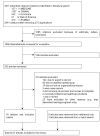Speaking up for patient safety by hospital-based health care professionals: a literature review
- PMID: 24507747
- PMCID: PMC4016383
- DOI: 10.1186/1472-6963-14-61
Speaking up for patient safety by hospital-based health care professionals: a literature review
Abstract
Background: Speaking up is important for patient safety, but often, health care professionals hesitate to voice concerns. Understanding the influencing factors can help to improve speaking-up behaviour and team communication. This review focused on health care professionals' speaking-up behaviour for patient safety and aimed at (1) assessing the effectiveness of speaking up, (2) evaluating the effectiveness of speaking-up training, (3) identifying the factors influencing speaking-up behaviour, and (4) developing a model for speaking-up behaviour.
Methods: Five databases (PubMed, MEDLINE, CINAHL, Web of Science, and the Cochrane Library) were searched for English articles describing health care professionals' speaking-up behaviour as well as those evaluating the relationship between speaking up and patient safety. Influencing factors were identified and then integrated into a model of voicing behaviour.
Results: In total, 26 studies were identified in 27 articles. Some indicated that hesitancy to speak up can be an important contributing factor in communication errors and that training can improve speaking-up behaviour. Many influencing factors were found: (1) the motivation to speak up, such as the perceived risk for patients, and the ambiguity or clarity of the clinical situation; (2) contextual factors, such as hospital administrative support, interdisciplinary policy-making, team work and relationship between other team members, and attitude of leaders/superiors; (3) individual factors, such as job satisfaction, responsibility toward patients, responsibility as professionals, confidence based on experience, communication skills, and educational background; (4) the perceived efficacy of speaking up, such as lack of impact and personal control; (5) the perceived safety of speaking up, such as fear for the responses of others and conflict and concerns over appearing incompetent; and (6) tactics and targets, such as collecting facts, showing positive intent, and selecting the person who has spoken up.
Conclusions: Hesitancy to speak up can be an important contributing factor to communication errors. Our model helps us to understand how health care professionals think about voicing their concerns. Further research is required to investigate the relative importance of different factors.
Figures
Similar articles
-
Classification of influencing factors of speaking-up behaviour in hospitals: a systematic review.BMC Health Serv Res. 2024 Dec 28;24(1):1657. doi: 10.1186/s12913-024-12138-x. BMC Health Serv Res. 2024. PMID: 39732664 Free PMC article.
-
Silence that can be dangerous: a vignette study to assess healthcare professionals' likelihood of speaking up about safety concerns.PLoS One. 2014 Aug 12;9(8):e104720. doi: 10.1371/journal.pone.0104720. eCollection 2014. PLoS One. 2014. PMID: 25116338 Free PMC article.
-
Trade-offs between voice and silence: a qualitative exploration of oncology staff's decisions to speak up about safety concerns.BMC Health Serv Res. 2014 Jul 14;14:303. doi: 10.1186/1472-6963-14-303. BMC Health Serv Res. 2014. PMID: 25017121 Free PMC article.
-
Improving safety through speaking up: An ethical and financial imperative.J Healthc Risk Manag. 2019 Jul;39(1):19-27. doi: 10.1002/jhrm.21360. Epub 2019 Apr 12. J Healthc Risk Manag. 2019. PMID: 30977243
-
Factors Influencing Nurses' Willingness to Speak Up Regarding Patient Safety in East Asia: A Systematic Review.Risk Manag Healthc Policy. 2021 Mar 12;14:1053-1063. doi: 10.2147/RMHP.S297349. eCollection 2021. Risk Manag Healthc Policy. 2021. PMID: 33737846 Free PMC article. Review.
Cited by
-
Why Not Blow the Whistle on Health Care Insurance Fraud? Evidence from Jiangsu Province, China.Risk Manag Healthc Policy. 2022 Oct 12;15:1897-1915. doi: 10.2147/RMHP.S379300. eCollection 2022. Risk Manag Healthc Policy. 2022. PMID: 36268183 Free PMC article.
-
Facing hierarchy: a qualitative study of residents' experiences in an obstetrical simulation scenario.Adv Simul (Lond). 2022 Oct 23;7(1):34. doi: 10.1186/s41077-022-00232-1. Adv Simul (Lond). 2022. PMID: 36274178 Free PMC article.
-
Raising professionalism concerns as a medical student: damned if they do, damned if they don't?BMC Med Educ. 2024 Feb 29;24(1):208. doi: 10.1186/s12909-024-05144-4. BMC Med Educ. 2024. PMID: 38424552 Free PMC article.
-
Impact of a Successful Speaking Up Program on Health-Care Worker Hand Hygiene Behavior.Pediatr Qual Saf. 2017 Jul 25;2(4):e035. doi: 10.1097/pq9.0000000000000035. eCollection 2017 Jul-Aug. Pediatr Qual Saf. 2017. PMID: 30229171 Free PMC article.
-
A mixed-methods evaluation of the MOREOB program in Ontario hospitals: participant knowledge, organizational culture, and experiences.BMC Health Serv Res. 2019 Jul 8;19(1):460. doi: 10.1186/s12913-019-4224-9. BMC Health Serv Res. 2019. PMID: 31286979 Free PMC article.
References
-
- WHO Patient Safety Curriculum Guide. WHO patient safety curriculum guide. http://www.who.int/patientsafety/education/curriculum/en/
-
- Edmondson A. Speaking up in the operating room: how team leaders promote learning in interdisciplinary action teams. J Manag Stud. 2003;14(6):1419–1452. doi: 10.1111/1467-6486.00386. - DOI
Publication types
MeSH terms
LinkOut - more resources
Full Text Sources
Other Literature Sources
Medical



